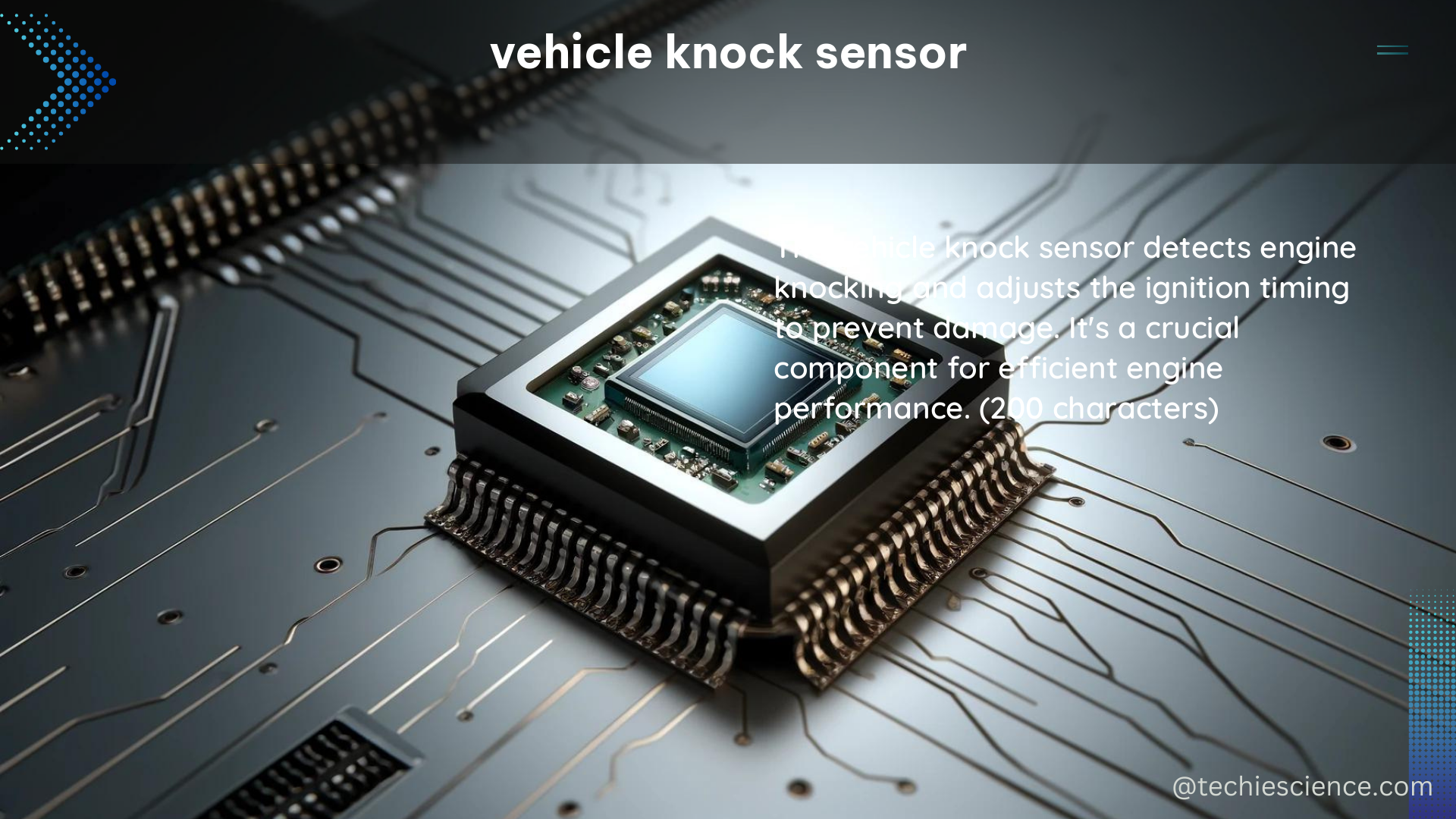The vehicle knock sensor is a crucial component in modern internal combustion engines, responsible for detecting knocking or pinging, which can lead to engine damage. This comprehensive guide will delve into the intricate workings of the knock sensor, providing you with a deep understanding of its technical specifications, signal processing techniques, and advanced applications.
Understanding the Knock Sensor: Piezoelectric Principle and Frequency Response
The vehicle knock sensor is typically a piezoelectric device that generates a voltage signal in response to mechanical stress. When the engine experiences knock, the vibrations generated by the knocking process are detected by the sensor, which then converts this mechanical energy into an electrical signal.
The sensor’s frequency response is tailored to the specific frequency range of engine knock, typically between 5 kHz and 15 kHz. This ensures that the sensor is sensitive to the vibrations associated with knock, while filtering out other engine noise and vibrations.
| Sensor Specification | Typical Range |
|---|---|
| Frequency Response | 5 kHz to 15 kHz |
| Voltage Output | 0 V to 5 V |
| Mounting Location | Near Engine Block |
The sensor is typically mounted in close proximity to the engine block, where it can detect the vibrations generated by engine knock. This strategic placement allows the sensor to accurately capture the knock signal, which is then processed by the engine control unit (ECU) to adjust ignition timing and prevent engine damage.
Signal Processing Techniques for Knock Detection

To extract the knock signal from the raw sensor data, the ECU employs various signal processing techniques. These techniques are designed to enhance the signal-to-noise ratio and improve the accuracy of knock detection.
Control-Oriented Combustion Modeling
One approach to knock detection involves the use of a control-oriented combustion model that is combined with the knock sensor signal. This method involves modeling the combustion process in the engine and using the model to predict the expected knock signal. The predicted knock signal is then compared with the actual knock sensor signal to detect knock, improving the sensitivity of the detection process.
Pattern Recognition Techniques
Another approach to knock detection involves the use of pattern recognition techniques, such as short-time Fourier transform (STFT) and wavelet-denoising. These techniques decompose the sensor signal into its frequency components and analyze the resulting frequency spectrum to detect the presence of knock. By identifying the unique frequency characteristics of engine knock, these algorithms can effectively extract the knock signal from the raw sensor data.
| Signal Processing Technique | Key Features |
|---|---|
| Control-Oriented Combustion Modeling | Combines combustion model with knock sensor signal to improve detection sensitivity |
| Short-Time Fourier Transform (STFT) | Decomposes sensor signal into frequency components to identify knock characteristics |
| Wavelet-Denoising | Removes noise from sensor signal to enhance knock detection accuracy |
These advanced signal processing techniques enable the ECU to accurately detect engine knock, even in the presence of other engine vibrations and noise.
Beyond Knock Detection: Additional Applications of the Knock Sensor
The vehicle knock sensor’s capabilities extend beyond just knock detection. It can also be utilized for other engine control applications, such as combustion phasing estimation and cylinder pressure modeling.
Combustion Phasing Estimation
By analyzing the knock sensor signal, the ECU can estimate the timing of the combustion process within the engine cylinders. This information is crucial for optimizing engine performance and efficiency, as it allows the ECU to adjust ignition timing and other parameters to ensure optimal combustion.
Cylinder Pressure Modeling
The knock sensor signal can also be used in combination with other sensors, such as accelerometers, to model the cylinder pressure within the engine. This data can be used for advanced engine control strategies, such as closed-loop combustion control, which can further improve engine performance and efficiency.
| Application | Key Benefits |
|---|---|
| Combustion Phasing Estimation | Optimizes engine performance and efficiency by adjusting ignition timing |
| Cylinder Pressure Modeling | Enables advanced engine control strategies, such as closed-loop combustion control |
By leveraging the knock sensor’s versatility, engine control systems can achieve a higher level of precision and responsiveness, ultimately leading to improved engine performance, fuel efficiency, and reduced emissions.
Conclusion
The vehicle knock sensor is a critical component in modern internal combustion engines, playing a vital role in detecting and preventing engine knock. This comprehensive guide has explored the technical specifications, signal processing techniques, and advanced applications of the knock sensor, providing you with a deep understanding of this essential engine component.
By mastering the intricacies of the knock sensor, you can unlock the full potential of your engine’s performance and efficiency, ensuring a smooth and reliable driving experience.
References
- Pla, B., Bares, P., Jimenez, I., & Guardiola, C. (2022). Increasing knock detection sensitivity by combining knock sensor signal with a control oriented combustion model. Applied Thermal Engineering, 194, 117702.
- “Explain how the Knock Sensor works signal wise…. PLEASE!” NASIOC Forums, 10 Oct. 2009, https://forums.nasioc.com/forums/showthread.php?t=1860711.
- “Knock levels – HP Tuners Bulletin Board.” HP Tuners, 18 Sep. 2023, https://forum.hptuners.com/showthread.php.
- DSG2003SVT. “Knock sensor reading question from my data logs.” SVTPerformance, 2 Aug. 2014, https://www.svtperformance.com/threads/knock-sensor-reading-question-from-my-data-logs.1028076/.
- “Knock sensor read – Project Guidance – Arduino Forum.” Arduino Forum, 14 Feb. 2018, https://forum.arduino.cc/t/knock-sensor-read/508341.

The lambdageeks.com Core SME Team is a group of experienced subject matter experts from diverse scientific and technical fields including Physics, Chemistry, Technology,Electronics & Electrical Engineering, Automotive, Mechanical Engineering. Our team collaborates to create high-quality, well-researched articles on a wide range of science and technology topics for the lambdageeks.com website.
All Our Senior SME are having more than 7 Years of experience in the respective fields . They are either Working Industry Professionals or assocaited With different Universities. Refer Our Authors Page to get to know About our Core SMEs.